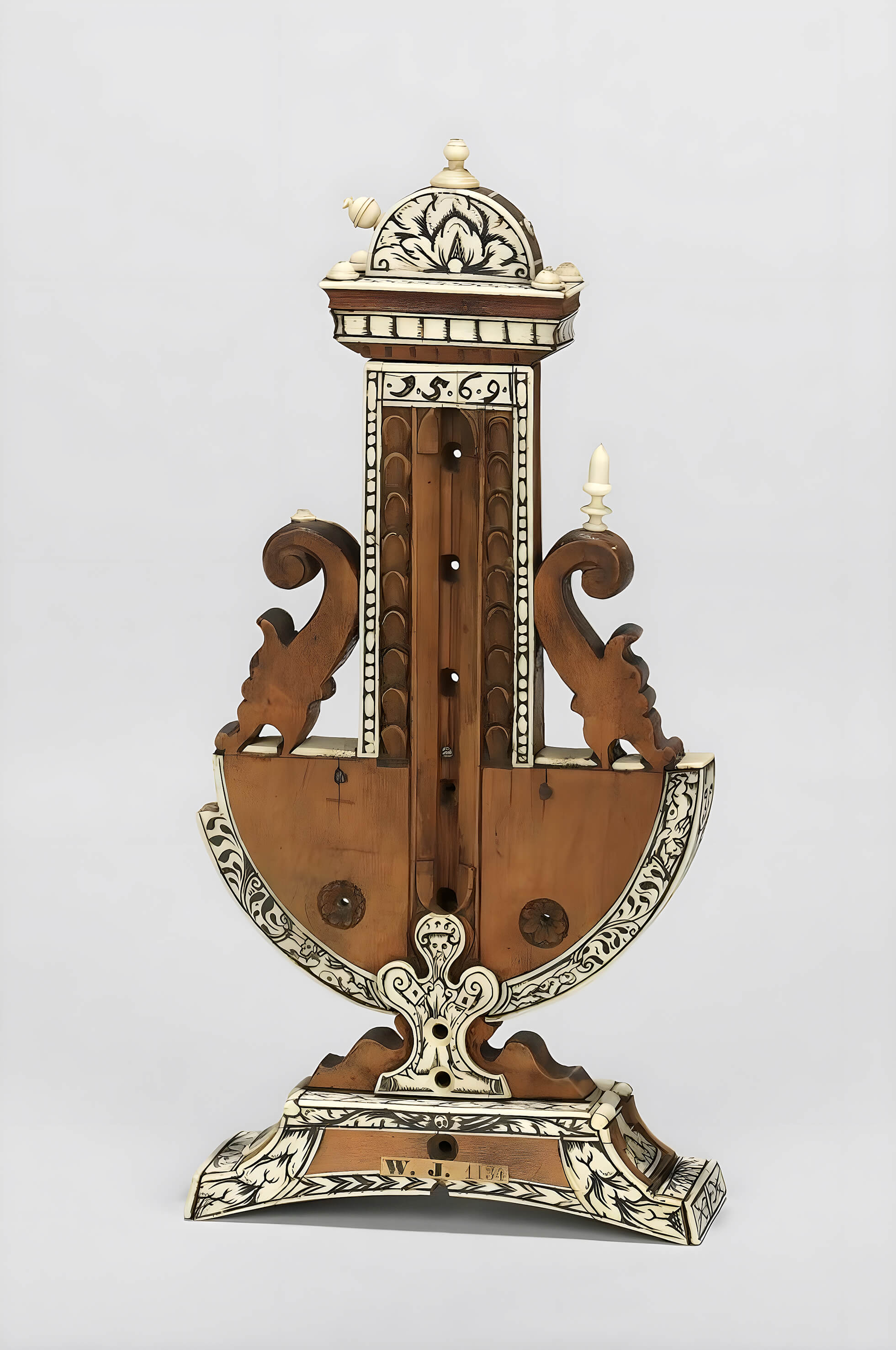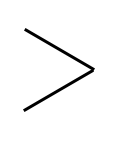The gunner's sight, incorporating pinholes and an inclinometer, is mounted on an elegantly shaped base, which is in turn mounted on a trapezoidal base with arc-shaped cut-outs on the sides and bottom.The sight and inclinometer lie in the same plane and are carved from a single plank of pear wood. The sight is surmounted by a cornice, which is decorated with small decorative bone hemispheres at the four corners, and in the centre is a semicircular holder plate, which is decorated with two miniature bone elements: one in the form of a sphere on a semicircular base, and the other at an angle in the form of an urn.It is noted that another element, probably in the form of an urn, is missing.
The inclinometer comprises two quadrant sectors that are symmetrical with respect to the sight, forming a semicircle whose diameter is perpendicular to the vertical of the sight bar; however, a small fragment has been lost.The inclinometer facilitates the measurement of angles from 0° to 90° to either side of the vertical, and its scale is marked along the arc, though not numbered.
The sight's bar and supporting base feature pinholes at regular intervals along the vertical axis, with two additional apertures positioned symmetrically about the vertical on the plane of the inclinometer, likely serving a decorative purpose.A scale ranging from 1 to 5, with a graduation value of ¼, is situated on the left side of the front bar, while an ungraded scale with a graduation value of ⅛ is positioned on the right.
A rather elegant arrow-shaped pendulum plumb bob, affixed with a metal pin, is utilised for the measurement of angles and the levelling of the gun horizontally. The plumb bob itself is also composed of silver metal.
Stylised figures of dolphins, with acanthus leaf ornamentation at the head, are inscribed in the right angles formed by the horizontals of the quadrants and verticals of the sighting bar, functioning as stiffeners. These figures are arranged in mirror symmetry with respect to the vertical axis, with their heads facing downwards.On the tail of one of them is a miniature bone candle, while the second candle is absent.
The instrument's base is adorned with two bone plates, ornamented with engraved and blackened embellishments, attached to hinges at the upper platform. The instrument's overall decoration follows a consistent technique.
The front surfaces of the sight's bar and inclinometer are lined with bone plates, on which various decorative patterns are engraved and blackened.The bar is framed on the sides by garlands of leaves. The surface of the inclinometer is subdivided into sectors, each of which features a distinct decorative motif. The uppermost sector is adorned with a ligature of curly shoots, the subsequent sector features bundles of fruit and leaves, and the image of the head of King Midas. The remaining two sectors are embellished with a leaf motif. The patterns exhibited by these sectors are replicated in accordance with the overall symmetry of the device.
The reverse sides of both the bar and the inclinometer are adorned with decorative friezes, with the majority of the wooden surface being left uncovered. A strip of moresques and putti figures is present along the arc, and the principle of symmetry is not observed: there are two figures on the right and one on the left (perhaps the second was on the lost fragment), and the poses of the putti vary in all cases. The plane of the sight's bar is bordered by thin strips of bone with engraved and blackened ornament of ovals and dots, the graphic source of which is a sheet from Christian Egenolf's model album 'Modelbůch Nehwens, Stickens, vnd Wirckens'[2]. Parallel to the edges of the bar is a relief scale pattern carved in wood, and the bar is closed at the top by a horizontal plate with figures:
× 1 × 5 × 6 × 9 ×
The anterior surface of the dolphin figures is also covered with bone, and their heads, fins, acanthus leaf, and teeth are traced with blackened engraved lines. The posterior surface and end faces are undecorated.The anterior surface of the shaped base is lined with a bone plate decorated with engraved volutes, vertical shading and leaves. The opposing side of the base remains unadorned, save for an inlaid and engraved element that incorporates a fantastical creature bearing a grotesque mask, accompanied by the inscription '1569'.
The horizontal plane of the base is covered with a bone plate, and its vertical planes are framed on four sides by thin strips of bone filled with garlands of leaves, and on the reverse side from below by geometric ornamentation in the form of double arrows.The central parts of the vertical planes of the base are devoid of inlay and show the texture of the wood.
The cornice crowning the sight's bar is adorned with a strip of bone running down the centre of the element, whilst on the front side, it is decorated with a garland of leaves; on the other three sides, there are vertical dashes spaced at equal distances.The upper surface of the cornice is covered with a bone plate decorated with a meander, whilst the semicircular holder is covered on both sides with an engraved bone plate. The front side features a partially erased grotesque mask, while the reverse side displays a blossoming flower. The end face of the holder is left open, with thin white stripes that extend throughout the thickness of the element and are spaced equidistant from each other.
[1] The description given on the museum's official website lists simply ‘Bein’ as one of the materials. See Kanonenrichtrichtgerät (WI1134) // Objektkatalog [Electronic resource]. URL: https://objektkatalog.gnm.de/wisski/navigate/70231/view (date of reference: 16.12.2023).
[2] Egenolff C. Modelbůch Nehwens, Stickens, vnd Wirckens. Frankfurt am Main: Christian Egenolff d.Ä. Erben, circa 1555. S. 37.
The inclinometer comprises two quadrant sectors that are symmetrical with respect to the sight, forming a semicircle whose diameter is perpendicular to the vertical of the sight bar; however, a small fragment has been lost.The inclinometer facilitates the measurement of angles from 0° to 90° to either side of the vertical, and its scale is marked along the arc, though not numbered.
The sight's bar and supporting base feature pinholes at regular intervals along the vertical axis, with two additional apertures positioned symmetrically about the vertical on the plane of the inclinometer, likely serving a decorative purpose.A scale ranging from 1 to 5, with a graduation value of ¼, is situated on the left side of the front bar, while an ungraded scale with a graduation value of ⅛ is positioned on the right.
A rather elegant arrow-shaped pendulum plumb bob, affixed with a metal pin, is utilised for the measurement of angles and the levelling of the gun horizontally. The plumb bob itself is also composed of silver metal.
Stylised figures of dolphins, with acanthus leaf ornamentation at the head, are inscribed in the right angles formed by the horizontals of the quadrants and verticals of the sighting bar, functioning as stiffeners. These figures are arranged in mirror symmetry with respect to the vertical axis, with their heads facing downwards.On the tail of one of them is a miniature bone candle, while the second candle is absent.
The instrument's base is adorned with two bone plates, ornamented with engraved and blackened embellishments, attached to hinges at the upper platform. The instrument's overall decoration follows a consistent technique.
The front surfaces of the sight's bar and inclinometer are lined with bone plates, on which various decorative patterns are engraved and blackened.The bar is framed on the sides by garlands of leaves. The surface of the inclinometer is subdivided into sectors, each of which features a distinct decorative motif. The uppermost sector is adorned with a ligature of curly shoots, the subsequent sector features bundles of fruit and leaves, and the image of the head of King Midas. The remaining two sectors are embellished with a leaf motif. The patterns exhibited by these sectors are replicated in accordance with the overall symmetry of the device.
The reverse sides of both the bar and the inclinometer are adorned with decorative friezes, with the majority of the wooden surface being left uncovered. A strip of moresques and putti figures is present along the arc, and the principle of symmetry is not observed: there are two figures on the right and one on the left (perhaps the second was on the lost fragment), and the poses of the putti vary in all cases. The plane of the sight's bar is bordered by thin strips of bone with engraved and blackened ornament of ovals and dots, the graphic source of which is a sheet from Christian Egenolf's model album 'Modelbůch Nehwens, Stickens, vnd Wirckens'[2]. Parallel to the edges of the bar is a relief scale pattern carved in wood, and the bar is closed at the top by a horizontal plate with figures:
× 1 × 5 × 6 × 9 ×
The anterior surface of the dolphin figures is also covered with bone, and their heads, fins, acanthus leaf, and teeth are traced with blackened engraved lines. The posterior surface and end faces are undecorated.The anterior surface of the shaped base is lined with a bone plate decorated with engraved volutes, vertical shading and leaves. The opposing side of the base remains unadorned, save for an inlaid and engraved element that incorporates a fantastical creature bearing a grotesque mask, accompanied by the inscription '1569'.
The horizontal plane of the base is covered with a bone plate, and its vertical planes are framed on four sides by thin strips of bone filled with garlands of leaves, and on the reverse side from below by geometric ornamentation in the form of double arrows.The central parts of the vertical planes of the base are devoid of inlay and show the texture of the wood.
The cornice crowning the sight's bar is adorned with a strip of bone running down the centre of the element, whilst on the front side, it is decorated with a garland of leaves; on the other three sides, there are vertical dashes spaced at equal distances.The upper surface of the cornice is covered with a bone plate decorated with a meander, whilst the semicircular holder is covered on both sides with an engraved bone plate. The front side features a partially erased grotesque mask, while the reverse side displays a blossoming flower. The end face of the holder is left open, with thin white stripes that extend throughout the thickness of the element and are spaced equidistant from each other.
[1] The description given on the museum's official website lists simply ‘Bein’ as one of the materials. See Kanonenrichtrichtgerät (WI1134) // Objektkatalog [Electronic resource]. URL: https://objektkatalog.gnm.de/wisski/navigate/70231/view (date of reference: 16.12.2023).
[2] Egenolff C. Modelbůch Nehwens, Stickens, vnd Wirckens. Frankfurt am Main: Christian Egenolff d.Ä. Erben, circa 1555. S. 37.
Unknown maker. Germany. 1569.
Pear wood, bone (possibly ivory)[1], metal.
Inlay, engraving.
23.5 x 11 x 4 cm.
Germanisches Nationalmuseum, Nuremberg. Inv. Nr. WI1134.
Pear wood, bone (possibly ivory)[1], metal.
Inlay, engraving.
23.5 x 11 x 4 cm.
Germanisches Nationalmuseum, Nuremberg. Inv. Nr. WI1134.





